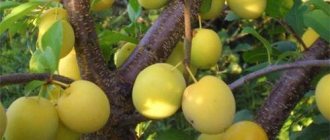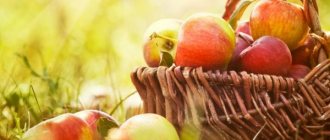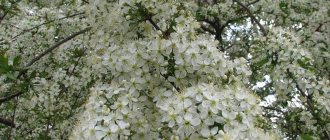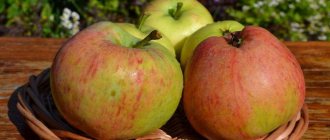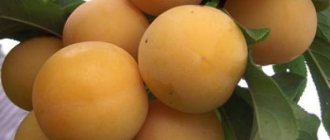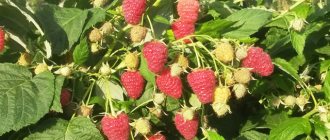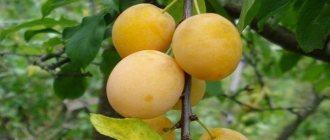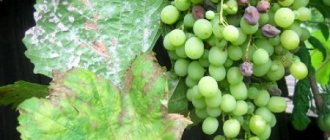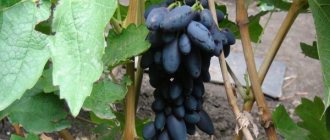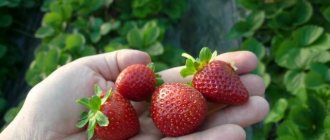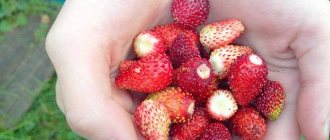Loading…
Loading…
Cherry plum of the Mara variety is a universal berry that can be eaten fresh, made into jams, compotes, preserves, and also added to baked goods. For those who want to grow it in their garden, we offer instructions for caring for such a plant as Mara cherry plum, a description of the variety, photos of trees and fruits. This cherry plum is considered a universal species of late ripening; it tolerates frost well and has high resistance to major phytodiseases.
Cherry plum Mara (Russian plum) was obtained by crossing cherry plum and Chinese plum. Hybridization was carried out by pollination. All such hybrids were called Russian plum, since breeding work was carried out in Russia.
Description of the variety
Photo:
Mara cherry plum trees have a wide and spreading crown of a round, pyramidal or weeping shape. When planting seedlings, it should be taken into account that the branches will actively grow up to three meters on both sides.
The bark of the branches and trunk has a brown tint. The stems of the crop are slightly curved. The leaves of the plant are green, shaped like an ellipse, and have jagged, crenate edges.
The root system is shallow and well developed. Cherry plum Mara is grown in areas with high groundwater levels (up to 2 m).
The lifespan of a tree is from 30 to 50 years. The active growth phase occurs in the first 10 years, and fruit buds begin to form in one-year-olds.
The Mara variety has good yield. Gardeners note a long shelf life compared to other similar varietal crops - up to several weeks at normal temperatures.
The plant needs a pollinator, as it is self-sterile.
A distinctive feature of this stone fruit crop is its high frost resistance (up to – 37° C), as well as resistance to many fungal diseases, including clasterosporiosis. When planting on good soil and in the right place, with regular sanitary measures, you don’t have to adhere to the schedule of preventive spraying against fungus.
Landing Features
Growing Mara cherry plum has a number of its own characteristics, the observance of which is necessary to obtain a rich harvest and ensure the successful growth of the plant.
Recommended timing
Plum trees are usually planted in the spring. It is during this period that the risks of freezing of the root system or damage to shoots are minimized.
Advice! Seedlings with a closed root system can be planted from mid-spring until October.
Choosing a suitable location
Cherry plum is a light-loving crop, so for planting it is best to choose the southern or southwestern side of the site with some kind of structure or fencing from the north winds. Groundwater should lie at a distance of about 2 meters from the surface of the earth. The variety prefers fairly loose neutral or slightly acidified soils.
What crops can and cannot be planted next to cherry plum
Yellow cherry plum Mara feels good next to apricots, other varieties of plums or cherries. It is not recommended to plant the crop next to tomatoes, eggplants, as well as trees and shrubs with a strong root system.
Selection and preparation of planting material
It is best to purchase seedlings that are about two years old, since they take root without much effort. When choosing planting material, it is important to pay attention to the following parameters:
- integrity of the root system;
- external condition of shoots and trunk;
- no signs of disease.
It is recommended to purchase seedlings of any plants, including cherry plums, only from trusted nurseries where real professionals are engaged in growing crops.
Landing algorithm
The main stages of planting cherry plum:
- Preparing a hole with a depth and diameter of about 75-80 cm. The top layer of soil is mixed with chernozem, peat and sand in equal quantities. You can also add about 2 kg of ash.
- A layer of crushed stone or expanded clay 10 cm thick is laid at the bottom of the pit.
- The hole is filled 2/3 full with prepared substrate, and a seedling is placed on top. The root system is covered with the remaining part of the soil, while the root collar should be flush with the soil.
- The seedling is tied to a peg, and a trunk circle is formed around the entire perimeter of the hole.
- Finally, the soil needs to be shed with 10-15 liters of water and loosened after a day.
Important! During planting, it is necessary to gradually compact the soil.
Fruit
The Mara cherry plum fruits are round, slightly flattened, and on average their weight reaches 23 grams. The dense yellow skin reliably protects the juicy, loose pulp. At the same time, the outer skin is white. The seed is small and difficult to separate from the pulp.
Cherry plum is juicy, tastes sweet and sour, with a taste of grapes, and has a bright yellow color. Tasters rate the taste at 4.2 points on a tasting scale (maximum 5 points).
Drupes contain more than 10% sugar - and this is quite a high figure. The fruits are perfectly stored, even at normal temperatures.
Chemical composition of Mara cherry plum pulp:
- titratable acidity -1.4-1.53%;
- dry matter content - 13.4-14.83%;
- total sugars - 9.8-10.13%.
Cherry plum Tent
Origin
Cherry plum Tent was artificially bred as a result of cross-pollination of a seedling of the Chinese-American Fibing plum with cherry plum at the Crimean experimental breeding station of the All-Russian Research Institute of Plant Growing named after. N.I. Vavilov by famous breeding scientists G.V. Eremin and S.N. Zabrodina.
Application
Cherry plum Shater is a universal variety. Suitable for both fresh consumption and processing. Makes good canned food.
Bloom
Very small flowers form inflorescences of 2 pieces. The petals are small, ovoid. The number of stamens is average, they are located above the slightly curved pistil. The calyx is campanulate, without pubescence. The sepals are bent from the corolla, pubescent, oval, green. The peduncle is thick and short.
The trunk is covered with smooth dark gray bark of medium thickness, the lentils are medium. The shoots grow horizontally and are of medium thickness. On the sunny side, a brown-red tan is noticeable.
Leaves
The leaves grow upward first and then take a horizontal position. The size is medium, the shape is oval, the tip is very pointed. The upper side of the leaf is green, wrinkled and slightly shiny. The lower one has weak pubescence along the central and lateral veins. On the wavy edges, double-crest serration is noticeable.
Fruit
The fruits are large, usually weighing about 32 grams. The shape is broadly ovoid, asymmetrical. The ventral suture is well developed, the apex is slightly elongated, the funnel is of medium depth. The skin is yellow-red with a solid purple blush and an average number of yellow subcutaneous dots. The waxy coating is not strong. The pulp is yellow-green, medium density, finely granular-fibrous in consistency, medium juicy. It gets dark slowly in the air. The taste is sweet and sour. The aroma is pleasant, but not strong. The skin is thick and peels off easily. The stone is medium in size and difficult to separate from the pulp. The peduncle is medium, without pubescence.
Fruit ripening is not simultaneous.
Chemical composition: solids – 11.0%, sugars – 7.1%, acids – 2.35%, sugar acid index 3.0, ascorbic acid – 7.04 mg/100g.
Bloom
The Mara cherry plum blossoms unusually beautifully and luxuriantly: before the leaves bloom, the tree is completely covered with flowers, most of which eventually turn into tasty and juicy fruits. During the flowering period, cherry plum needs pollinators.
The size of the flower of the crop is approximately 2-4 cm. Flowering begins in central Russia in early May. However, this fabulous process does not last long - 7-10 days. The rest period is short. During flowering, the Mara cherry plum is often overtaken by return frosts.
Description and features of plum
The fruitful tree reaches an average height of 2.5-3 meters. On its ash-gray trunk there is a round, flat crown with organically germinating shoots of medium foliage. Each oval plum leaf is slightly pointed at the upper base. When compared with other varieties, the Naiden cherry plum variety is quite modest in cutting, but all the richness comes during the flowering and fruiting period.
The beautiful fruits of the Naidena variety ripen in a thick scattering, each weighing up to 30 g; the oval fruit has a dense skin and bright orange pulp. There is no ventral groove on the plum, its appearance is ideal - it is a uniform shade of deep burgundy or red-violet, with a shimmering waxy coating. The brown seed is firmly located in the middle of the fibrous pulp. The fruit has a fruity, warm aroma with notes of sloe and mountain cherry plum.
Pollinators
Cherry plum Mara belongs to the category of self-sterile plants, so the pollination process can be somewhat problematic. As a result, frozen and unpollinated flowers may not meet the owners’ expectations for a rich harvest. Sometimes the ripening of fruits may even be at risk.
Advice: Only simultaneously flowering varieties of the same crop serve as neighboring pollinators.
Pollination will not occur if Mara cherry plum and cherry grow in the same area. Self-sterile crops cannot serve as pollinators for each other. However, not every summer resident can afford to plant several cherry plum trees on his plot.
As a rule, 3 varieties are planted with different ripening periods, but one of them should belong to the average ripening period. It is he who will become a pollinator for his “brothers”. For successful pollination, you should clearly calculate the flowering time of all 3 varieties so that the flowering phases overlap.
If you still don’t have room for 3 trees, you can plant one and plant other varieties of pollinators on it - from 2 to 3 pieces. They will favor the pollination process.
If grafting is carried out in the spring, the trees take root quite well. The best method is budding.
The main helpers in pollinating cherry plums are bees. Only rain can stop them from doing their good deed. But to attract their attention, you can spray the tree with honey infusion.
Its recipe is simple: for one adult tree you need to dilute 1 tbsp. l. honey in 1 liter of water.
Having made some efforts, you will not be left without a harvest.
The best pollinator for Mara cherry plum is the common wild plum variety Vitba.
Pollination of the variety
The lack of ability to self-pollinate means that without additional sources of pollen, no more than 4–5% of flowers will be fertilized, so pollinators must grow next to Mara. It must be remembered that the domestic plum does not pollinate the cherry plum; cross-pollination is possible only between representatives of the group of diploid plums.
For cross-pollination between plums to occur, they must bloom at the same time.
The best pollinators for Mary are the Russian plum varieties Vitba and Asaloda, and wild cherry plum is also suitable for this purpose.
Productivity
Cherry plum Mara belongs to late and medium ripening varieties. The harvest is harvested towards the end of August - the first ten days of September.
The crop is characterized by good yield; about 40 kg of fruit can be obtained from one tree.
Cherry plum Mara begins to bear fruit 2-3 years after planting on a seed rootstock with a planting pattern of 5x3 m. In particularly favorable conditions and with good care, the first fruits can be harvested in the second year of planting.
Maximum fruiting occurs at approximately 6-7 years. And after the 10th year of growth, the harvest from one tree will already be 300 kg.
In some regions, you can enjoy sweet cherry plum by mid-August. And it is not recommended to delay harvesting. The fruits of Mara do not hold very firmly on the branches: there is a possibility of falling off due to strong gusts of wind or heavy rain. It is advisable to collect ripe cherry plum once every two days.
If the fruits do not have time to ripen, it does not matter. If you carefully put them in wooden boxes, the cherry plum, even during transportation, will ripen and acquire its rich color.
The best way to store Mara fruits is in a pre-prepared basement with an air temperature of -6 to +4 °C and a constant humidity of 85-95%. The storage area should be fumigated with sulfur dioxide. In such conditions, the fruits will be stored for 3 to 5 months.
In addition to fresh consumption, Mara cherry plum is an ideal variety for processing and canning. The fruits of this tree are used to prepare:
- jam;
- jam;
- compote;
- jam;
- marshmallows;
- marmalade.
Cherry plum Mara is also an indispensable component in recipes for the preparation of many hot sauces and dressings that are served with fish and meat dishes.
Also, Mara can be frozen: put in 200 g portions in special bags for freezing. Wash and dry first, do not remove seeds.
Features of growing hybrid cherry plum Mara
Growing the described variety is not particularly difficult, since it is extremely unpretentious and is generally cultivated using standard agricultural technology for plums.
Landing
In warmer regions, cherry plum takes root better when planted in the fall and grows early in the spring. In difficult climates, it is better to plant it in the spring before the sap begins to flow. The layout of tall Mary trees during mass plantings is 3x5 m. In amateur gardens, row spacing can be reduced to 4 m. The conditions for growing cherry plum and domestic plum are similar in almost everything, but there are still some peculiarities.
A young plum planted in the spring can bloom the same year, but it is better to cut off these flowers so that the tree does not waste extra energy and takes root faster
Varieties of most parent forms of Russian plum (cherry plum, Chinese, Ussuri and American plums) in climates with alternating frosts and thaws have a greater tendency to overheat the root collar than domestic plum. The hybrid cherry plum has the same property, so conditions should be created for it to prevent this undesirable phenomenon. In places with a natural decrease in relief, it is recommended to plant trees on a mound 0.6–0.7 m high. When placing a seedling in a planting hole, be sure to ensure the correct location of the root collar: it should not be below the soil level. Otherwise, the planting process has no special features.
In places with a natural decrease in relief, it is better to plant the Russian Mara plum on a mound
Plant care
To limit the height of the tree, it is best to form the crown of Mary in the form of a bowl. Of course, such a formation for a tall tree is more labor-intensive to implement than a sparsely-tiered one, but it provides many advantages: good lighting and ventilation of the inside of the crown, ease of care and harvesting. Also, in cold climates, it is not recommended to use a leader formation (skeletal branches are left evenly along the trunk at a great distance from each other, and the main trunk is cut off), because the tree will freeze.
The crown of the Mara plum is best shaped into a bowl.
It should be taken into account that the bowl-shaped crown cannot be left without care; it must be thinned out regularly. The Mary tree is fast-growing; shoots can stretch up to 1 m during the season. It is important to shorten them in a timely manner, since heavy pruning of a neglected tree can provoke excessive branching. They also don’t forget about sanitary pruning.
Video: how to properly trim the crown of a Russian plum
The sources do not contain information about the drought resistance of the variety, and it is also known that the Russian plum needs a sufficient amount of moisture for full development, so during the dry season it is better to provide the plants with regular monthly watering. Young trees are watered more often, up to 6–8 times per season. When there is a large amount of precipitation, the frequency of watering is reduced, since stagnation of water will not benefit the trees, but, on the contrary, will cause harm. The root system of cherry plum is shallow; it will be enough to moisten the soil to a depth of 25–35 cm.
The root system of the Russian plum is located at a depth of 25–35 cm
Nutrients are added according to the usual scheme for plums, taking into account that cherry plums differ from common plums in having a longer growing season. Excessive or untimely (in the second half of summer) application of nitrogen fertilizers can lead to a decrease in the winter hardiness of immature shoots. Also, in plants overfed with nitrogen, the quality of the fruits deteriorates. To increase productivity, it is worthwhile to fertilize with potassium during the period of fruit formation.
Potassium fertilizing to increase fruiting is carried out when the ovaries of the cream are the size of beans
The resistance of a variety to diseases does not exempt it from standard preventive measures, which are effective against pest damage. By providing plants with good care and regular sanitation, some gardeners manage to do without protective chemical treatments.
In winter, attention should be paid to preventing the root collar from becoming warm: during thaws, it is imperative to clear the trunk of wet snow. In spring, it is necessary to dig drainage grooves to drain melt water from the trunk.
In the spring, you need to dig drainage grooves around the perimeter of the tree trunk to drain melt water from the plum trunk
Geographical and climatic features
Cherry plum Mara is a southern crop with increased frost resistance, so its planting and cultivation is feasible in regions with harsh climatic conditions.
Gardeners characterize Mara cherry plum as an exceptionally reliable variety, which has proven itself first in Belarus, and then in central Russia and the Volga region. In the Vladivostok region, if the weather is good, the fruits ripen in mid-September. Good conditions for the growth of Mara cherry plum are observed in the Moscow region.
Note: When growing Mara cherry plum in regions where frosts in winter reach below 30° C, it is recommended to use a special shelter. The crop is resistant to heating and is not damaged by covering materials, snow or soil.
Characteristics
A distinctive feature of this crop from other plum varieties, most often grown in the south, is its high frost resistance and resistance to pests and diseases. This is why the Mara cherry plum feels great in the Moscow region and other central regions.
Drought resistance, winter hardiness
The main characteristic of the Maara cherry plum variety is winter hardiness. The culture can tolerate temperatures down to – 35-37 °C.
Drought resistance is average. During long periods without precipitation, the plant must be provided with proper watering.
Pollination, flowering period and ripening time
The plum variety is self-sterile, so pollinators for Mara cherry plum are needed to obtain a harvest. First of all, these are other plum varieties that have similar flowering periods, for example, Vitba.
Flowering occurs quite late - at the end of April or beginning of May. The period of fruit ripening occurs in the third decade of August or even at the beginning of September. These terms depend on the region where the crop is grown and the climatic conditions.
Productivity, fruiting
The high yield of Mara cherry plum is one of the main advantages of the variety. Starting from the third year after planting, about 37-40 kg of juicy and ripe fruits can be collected from each mature tree. Maximum fruiting begins around the 7th year of life, then the harvest can reach more than 60 kg.
Area of application of fruits
The fruits of this plum variety have excellent taste, and reviews of Mara cherry plum are the main confirmation of this fact. According to the tasting assessment, the fruits receive 4.2 points out of a maximum of 5. The pleasant aroma and sweet and sour taste allow the plum to be used for preparing compotes, various sauces, as well as for making preparations for the winter.
Resistance to diseases and pests
The Mara variety has quite high resistance to fungal or viral diseases, as well as pests. Regular preventive measures allow you to avoid any contamination of the crop for a long time.
Advantages and disadvantages
The main strengths of the Mara variety are:
- high productivity;
- large fruit;
- winter hardiness and drought resistance;
- immunity to many diseases and resistance to pests;
- excellent taste of the fruit.
The weaknesses of culture are:
- self-sterility;
- late periods of flowering and fruiting.
Despite these minor drawbacks, the Mara plum is still considered one of the best crops suitable for growing in regions with cold and unstable climates.
From the history of the appearance of the variety
The hybrid was named “Russian plum” because breeding work was carried out in Russia. However, this varietal variety is the original fruit of Belarusian breeders. Scientists obtained a new stone fruit crop through open pollination by hybridizing cherry plum and Chinese plum.
In 1999, the variety was registered in the State Register of Varieties and Tree and Shrub Species of the Republic of Belarus, and 3 years later - in the State Register of Breeding Achievements of the Russian Federation for the Central Region.
Specifics of cherry plum care
For the proper development of the tree and obtaining a high-quality harvest, strive to adhere to the tree care technology as closely as possible. Care, consisting of properly organized work - regular watering, pruning, fertilizing, prevention and protection from diseases and insects - will ensure the health of the tree and high yields for the owner.
The uniqueness of the cherry plum watering process
Cherry plum Traveler loves sufficient watering, but not excessive. Begin to water the young tree with 1-2 buckets of water. Gradually, as the plant matures, the volume of moisture added increases to 6 buckets per plant
Please note that winter watering is not recommended. To prevent water from thawing on the root collar of the crop during snow thawing, drainage diversion channels are made
Fruit tree pruning
Pruning of cherry plums is carried out regularly in the spring and autumn. During the process, sharp tools are used - knives, pruners, saws. The cut site is treated with garden varnish to protect against the development of diseases. In accordance with their purpose, the following types of procedures are distinguished:
- formative pruning,
- sanitary,
- thinning,
- rejuvenating.
Formative pruning is intended to form the crowns of young seedlings. The first time is carried out in the spring a year after planting the tree. Branches are cut by 1/3. Over the next 3-4 years, crown formation is maintained. Sanitary – during the cherry plum growing season, disease-affected, dry branches are removed. Thinning – is the removal of excess branches that cross, thicken the crown, and do not bear fruit. Growths reaching a length of 1 meter are cut to 40-50 cm. Helps increase the illumination of the tree. Anti-aging pruning extends the life of mature trees. After it is carried out, new young shoots appear.
Fertilizing the crop
If the soil for the seedling has been previously fertilized, the plants begin to be fed after 2 years of growing season. Fertilizing with organic fertilizers (humus, compost, manure) is applied in the fall every 2-3 years at the rate of 10 kg per square meter. Fertilizing with mineral fertilizers should be carried out 5 times per season. Apply fertilizer per square meter:
- During bud break – urea 50-70 g, potassium salt 20-30 g.
- Before flowering of the plant - urea 50-70 g, potassium salt 20-30 g, ammonium nitrate 70-90 g.
- When forming the ovary - urea 50-70 g, potassium salt 20-30 g.
- During the fruiting period - superphosphate 50-60 g, potassium sulfate 150 - 180 g.
- After harvesting - superphosphate 40-50 g, potassium salt 20-40 g.
Conditions for a successful landing
When choosing a place to plant Mara cherry plum, do not forget that light is extremely important for this plant. When it is deficient, fruits lose their juiciness and sweetness, and harvest volumes are sharply reduced.
And although Mara is not afraid of frost, she should also be protected in especially harsh weather. The ideal place for growing cherry plum is the space between two objects on the site, for example, between a house and a bathhouse or between two barns. It is optimal if the brick building is located on the north side. When heated, the brick is able to heat the plant and protect it from the winds.
The fruit tree is negatively affected by stagnation of moisture, and it may even die. Therefore, in order to prevent this situation, you should ensure that the plant “leaves” water:
- drainage can be applied;
- plant the crop on a hill.
Sandstones or loams are best suited for growing cherry plums. The acidity should be neutral. But Mara is not particularly picky about soil.
Planting: step by step instructions:
- Mara cherry plum seedlings are recommended to be planted in spring or during the spring–October period (for plants grown in containers).
- Organic fertilizer is placed in the hole before planting; you can add superphosphate and potassium. Eliminate nitrogen at this stage.
- Before planting, the roots of the seedling must be temporarily immersed in a clay mash mixed with a drug that stimulates root growth - heteroauxin.
- There is no need to plant the seedling very deeply: the root neck should be 5 cm above ground level. The root system is located at a depth of 0.3–0.4 m.
Rules for planting trees
Before purchasing seedlings and planting them in the ground, you need to familiarize yourself with the basic rules for caring for Mara cherry plum, a description of the variety and a photo of the harvest. When choosing the best place for planting, it is necessary to take into account that cherry plum grows well and bears fruit only in sunny areas. If there is insufficient lighting, the fruits lose their sweetness, and the harvest volume is significantly reduced. The trees are frost-resistant, but you should choose windless places in the garden close to the house or outbuildings.
In order for the seedlings to take root better, the soil is fertilized with compost, potassium or phosphate additives.
Cherry plum does not tolerate heavy watering, so you need to avoid stagnation of moisture in the soil. If you plant seedlings on a small hill, you can avoid this problem. The most comfortable soil types are loamy or sandy loam, but the variety is not particularly picky about the soil. The first harvest can be obtained 2-3 years after planting the seedlings.
Care
According to reviews from professional gardeners, if natural protection is used wisely, the number of sanitary treatments can be significantly reduced. For example, against invasions of various caterpillars and aphids, you can successfully use celandine by spraying the crown with a decoction of plucked plants or planting grass on a tree.
When the fruits begin to fill, it is recommended to fertilize the plant with nitrophoska or urea. After the first harvest, the cherry plum is fed with superphosphate and potassium sulfate. Organic matter is added in late autumn and early spring.
Mineral-rich and fertile soils do not need frequent fertilization, but poor and sandy soils need regular feeding.
In the first year of life, it is necessary to cut off all the flowers of the tree: this way the crop will take root better.
Next year the harvest should be rationed. To do this, half of the ovaries are removed. This way the fruits will be bigger and sweeter. Removing the ovaries also helps regulate fruiting - every other year.
Watering should be regular - about 5 times a month (morning and evening), 1 bucket per adult tree.
Trimming
Proper pruning will not only help control the yield and size of Mara cherry plum fruits, but will also eliminate various diseases.
When planting, the branches of the seedling are cut by one third: this will speed up the process of crown formation.
If the annual growth decreases, the branch must be cut back to older wood.
It is advisable to prune the crop every spring - before the buds begin to bloom. At the end of autumn, pruning is not recommended.
If there is a need for complete pruning, the cut is made at the base of the branch and the “stumps” are also cut off. If branches with fruits fall to the ground, they need to be removed.
Every year it is worth thinning out the crown of the tree: this will help increase the yield and prevent the development of diseases and pest attacks.
Only straight and healthy young stems remain. Thin and crooked lines are removed.
Important: Under no circumstances should you remove many shoots at one time. This will be stressful for the tree. It is allowed to cut no more than a quarter of the total amount at a time.
Pest varieties
In addition to diseases, when growing cherry plums you sometimes have to deal with pests. To prevent insects from appearing on the site, preventive procedures must be carried out. The soil is dug up in the fall after the leaves fall. Insects like to overwinter in the soil and move to fruit trees in the spring.
In early spring, preventive spraying with Bordeaux mixture is carried out, even if there are no signs of pests. Regularly destroy weeds growing on the site.
codling moth
To treat codling moths, use a mixture of the drugs “Senpai” and “Mospilan” or “Kinmiks” together with “Imidocloprid”. After 2-3 weeks, the trees are re-treated with a mixture of Sonet and Bankol preparations. These two treatments are enough to destroy the codling moth.
Sawfly
To combat the sawfly, the drugs “Karbofos”, “Metafos”, “Benzophosphate” are used. The trees are sprayed for the first time before flowering begins. The second time was when the petals of the inflorescences fell. A month before harvesting, the trees are re-treated with Metaphos or Phosfamide.
Centipede
First of all, you need to collect all the fallen leaves, fruits and seeds from the ground. Then they inspect the tree and remove damaged fruits. In spring and autumn, the soil is dug up. Among the effective chemicals, Confidor, Sonnet, and Calypso are effective.
Diseases of cherry plum Mara
Cherry plum Mara suffers from the same pests and diseases as its closest relative, the plum. To take the necessary and timely measures, you need to know the signs of each disease and how to combat it.
Clusterosporiasis (hole spotting)
The leaves are affected by brown spots with dark borders. Over time, the affected parts die off, and holes appear in their place. Dirty red spots also appear on the fruits, they begin to deform. Light red spots appear on the branches, the bark begins to crack and gum may leak out.
To combat clasterosporiasis, you need to burn plant residues in the fall. And when coloring the buds, you need to treat them with a solution of Bordeaux mixture or the drug Hom. If the disease is very severe, then 20 days before harvest you need to spray the tree again.
Also? The tree should be constantly pruned.
milky shine
This is a fungal disease. A light silver coating appears on the leaves. This can happen when the tree freezes. The plant may dry out. If you regularly care for the cherry plum, feed it seasonally and water it according to schedule, after 1–3 years it will fully recover.
To cure cherry plum, you need to treat the affected areas with copper sulfate and coat with garden pitch. Skeletal branches and trunks need to be limed.
Diseases and pests of cherry plum
Mara is considered resistant to pests and fungi. But some diseases affect her. They manifest themselves with certain signs that you definitely need to pay attention to. Diseases include:
- Polystigmosis. This is a fungus that attacks the leaves of the plant. They become covered with brown spots and fall off. The taste of the fruit changes for the worse. Fungicides are used to combat the fungus.
- Gommoz. It appears in places where the cortex is damaged. A large amount of gum is released at the injection site. To prevent disease, the damaged area is cleaned, treated with copper sulfate, and covered with garden pitch on top.
- Moniliosis. Gray formations appear on trunks and branches, the color of the bark changes, and a grayish tint appears. A gray fungal coating forms on the fruits. Damaged branches are cut off. For prevention and control, the tree is sprayed with a solution of Bordeaux mixture.
- Milky shine. The most dangerous disease for Russian plums. The leaves lighten and become almost white. For treatment, the affected branch is completely cut off.
The tree is also affected by insect pests:
- Centipede. A beetle whose larvae get into the seed of the fruit and eat it from the inside. The drupes fall off.
- Plum sawyer. The larvae of this beetle penetrate cherry plum flowers, damaging the ovary and the fruits themselves.
- Plum moth. Eggs are laid by butterflies, penetrate inside the drupe and completely eat it away from the inside.
For prevention and control, it is recommended to treat the plum with insecticides before the ovary begins.
Popular varieties
Thanks to the efforts of breeders, varieties have been developed that survive well in frosty winters. At the same time, the quality characteristics of the fruit are significantly improved. The drupes have become larger. Productivity has increased. The shape and color of the fruits of different tree varieties pleases with their diversity, from amber-yellow to burgundy and purple. You can choose varieties with different qualities. Sweeter, sweet and sour, juicy or those that are suitable for drying.
Most of all, they have taken root in mid-latitudes:
- varieties Shater, Kuban Comet, Found. These are varieties that have fairly large fruits (up to 40 grams) of burgundy color with yellow flesh. All three varieties tolerate winter well. They differ in productivity. Ripen in August.
- varieties Gift of St. Petersburg, Zlato Skifov, Maara. These are low-growing and medium-growing frost-resistant varieties with yellow berries. The fruits are not very large. Valued for disease resistance and good winter hardiness.
- Variety Traveler. Early Russian plum with burgundy fruits. It pollinates other cherry plum varieties well.
- Lama. A very beautiful tree with burgundy-purple fruits and reddish leaves. Fruits up to 40 grams.
What Mara cherry plum looks like: description of the variety, photos, reviews
I often saw cherry plums among my neighbors, but for some reason I thought that these yellow fruits that drenched the branches were sour. One day I was treated to a whole basket. She didn’t refuse - it’s a natural product. Let me think, I’ll add some sugar and make some jam... Just for fun, I took a bite of one fruit...
By evening there was no jam or fruit in our house - the children and I ate it clean. That same fall we went to the nursery to look for the same variety, fortunately, the neighbor remembered exactly the name of his generous tree. Now we are growing hybrid cherry plum and cannot be happier.
Late ripening varieties
The ripening period of these varieties is extended from September to October. Traditionally, their fruits are stored the longest and are not used for canning for the winter.
Gift to Primorye
Gift to Primorye
Gift to Primorye A tree of medium height with a pyramidal crown. The crown density is average. Ripening time - 1st ten days of September. It has good frost resistance and disease resistance. Suitable for growing in Siberia. Requires planting of other varieties for cross-pollination.
The fruits are oval-shaped, purple in color. The pulp is red in color and has a fibrous structure. Branches may break under the weight of the fruit.
Mara A late-ripening plant with increased frost resistance (down to minus 38°C). Has good immunity to diseases. The crown is formed into a spherical shape. A fast-growing variety, capable of bearing fruit in the second year of life.
The color is bright, orange-yellow. The fruits have a round shape. The taste of the pulp is dessert, with a faint taste of grapes. It is difficult to separate the bone from the pulp.
This variety has a very long (for cherry plum) shelf life, reaching 2.5-3 weeks.
General information about the variety
According to the description, Mara cherry plum grows quickly, especially while young. By 3-4 years of age it reaches a height of 3-4 meters. The crown is spreading, spherical, the branches are densely spaced. The bark is brown on the stem and old branches; young shoots have a burgundy tint.
The tree has large yellow fruits, slightly flattened, one fruit weighs about 20 grams. The skin is dense, the flesh inside is loose and juicy. The stone is small in size and difficult to separate from the pulp. The fruit has a sweet and sour taste, similar to grapes. One tree produces up to 40 kilograms of drupes. Full ripening occurs at the end of August. At normal temperatures, the fruits are stored for several weeks.
Seedling care
They care for Mara according to the scheme familiar to plums. The garden is watered when there is insufficient rain and fertilized regularly. To maintain a soil reaction that is comfortable for trees, dolomite flour and wood ash are added to the tree trunk circle. This is especially true for acidified soils. This type of agricultural practice has the additional advantage of supplying plants with nutrients.
The tree trunk circle is weeded and mulched. If growth appears in the standard area, it is removed. Trees are pruned in the spring. Due to the exceptional productivity of the variety, it makes sense to cut off some of the ovaries. Then the drupes grow larger, up to 30 grams.
Maru is propagated by budding or by rooting green cuttings. The easiest way is to buy ready-made seedlings. They are offered in abundance by nurseries and garden farms. This cherry plum loves sunny areas, so it is given enough space.
If planting is carried out in the northern regions, then a plot without drafts is provided in advance. On the contrary, it is better that the height of the snow cover around the trunk is higher, and the tree overwinters “under a blanket.” The planting hole is filled with organic and mineral fertilizers, the seedling is positioned taking into account future shrinkage and tied to a peg for stability.
“Question and answer” section about growing cherry plum
To obtain a large number of fruits, it is necessary to observe several growing features, choose the right planting site, select suitable soil, and observe the period of transfer to open ground.
When to plant
If the root system is poorly developed - bare, then the seedlings are transferred to the soil in late spring. For a tree grown in a pot, the planting period is longer: from late spring to early October.
Cherry plum produces a lot of fruit and grows well in sunny areas. Choose a place with sufficient lighting near the house or outbuildings. If there is not enough light, the harvest decreases in quantity, the fruits lose their taste. The tree does not tolerate drafts well, so choose places protected from them.
Planting process
Dig a hole of the required depth. Water with warm water and allow time to absorb. Apply mineral or organic fertilizers. Transfer the seedling to a hole and sprinkle soil on top. There is no need to clean the roots before planting. The end of the root should rise slightly above the ground, 4-5 centimeters.
Columnar
Cherry plum Colonoid
Perhaps the most unusual and compact cherry plum variety. The tree grows up to 3 meters in height, while the crown diameter does not exceed 1.5 meters. The variety is not afraid of frost and recovers very quickly after freezing, while other species begin to wither and slowly die. The fruits are very large, their weight can reach 40 grams, the skin is rich red in color with a slight waxy coating, is not afraid of heavy rainfall and is not prone to cracking. The pulp is tasty, juicy, fibrous.
Ruby
Cherry plum Rubinova
The low tree does not require complex care and adapts perfectly to any weather conditions. The variety does not suffer from sudden changes in temperature and at the same time bears bright burgundy fruits with dark yellow, honey-like pulp. The taste of cherry plum ripening in mid-summer lacks sourness, which is very attractive to lovers of sweet fruits.
Scythian gold
Cherry plum Gold of the Scythians
The variety was bred in 2005 and is a tree that grows no more than 3 meters in height with a crown shaped like a wide cone. The large fruits have a rich, golden skin color. The pulp is very sweet, juicy and tender. The tree is not afraid of a sudden change from cold to heat and vice versa, it does not require long-term attention, while the Zoloto Scythians variety bears fruit very early and annually. The harvest size is average and requires additional pollination.
Precocious
Cherry plum Skoroplodnaya
Chinese variety. The tree is small; already in 2-3 years of life it can bear the first harvest of medium-sized reddish fruits. The pulp is very pleasant, tender and tasty, the stone is easily separated, which is why such fruits are well suited for fresh consumption. It is resistant to frost and gusty winds and requires planting a pollinator tree nearby.
The achievements of modern selection make it possible to grow cherry plum not only in the southern regions, but also in the central part of Russia. If desired, every gardener can try to grow a tree with excellent and tasty fruits on their plot.
Breeders have bred more than 100 varieties of cherry plum. All these varieties are different:
- According to the ripening period.
- The size, color and taste of the fruit.
- Productivity.
- Winter hardiness.
- Size and shape of trees.
This page contains descriptions of the most famous and popular varieties of cherry plum or “Russian plum”. There are photographs of each variety, characteristics and brief recommendations for planting and care.
It was the plum that served as the rootstock for breeding hybrid forms and new varieties of heat-loving cherry plum for the Moscow region. Today, cherry plum is divided into several groups, which are varieties of wild cherry plum growing in the southern climate zone. Back in the last century, domestic breeders developed a hybrid form based on the Chinese plum, from which new winter-hardy varieties were obtained.
Now breeders have given these varieties an informal joint name - “Russian plum” - an ordinary plum with a specific sour taste. Cherry plum varieties for cultivation in the Moscow region have the best qualities obtained from plums - high winter hardiness and large fruit, and directly from the cherry plum itself - excellent taste.
Question No. 1. How can a rainy summer affect cherry plum?
Due to lack of heat, the fruits of many crops have significantly deteriorated their quality (taste, marketability). But the prolonged rains had no effect on the cherry plum. Some of its fruits turned out to be even much larger than usual. When the soil is very waterlogged, the fruits of many crops usually crack, rot and become inedible.
Precocious
Early ripening varieties
Almost all representatives of the Plum genus ripen late. Therefore, for plums and cherry plums, “early ripening” means readiness for harvest in late July/early August.
The indicated dates correspond to the Middle Belt or Moscow region. Depending on climatic conditions, ripening dates may shift by 1-2 weeks (the further south, the earlier).
July rose
July rose
July rose Record holder for ripening time (2-3 decades of July). High frost resistance and drought resistance. Fungal resistance. Has stable fruiting. Easily adapts to new climatic conditions.
The peel is red, thin. The pulp is dark yellow, of moderate density with a rich and pleasant sweet and sour taste. The versatility of fruit use.
Found
Found
A tall tree with a flat, rounded crown was found. Buds with flowers bloom relatively early in the spring, sometimes even in April. It is self-sterile, requires pollinators (for example, Vladimir comet, Timiryazevskaya, etc.)
A high-yielding mid-early variety that begins to bear fruit in the second year of life. Has average immunity. The top of a mature tree should be trimmed regularly.
The fruits are large and ovoid in shape. The skin is durable and does not crack even when dropped. Its color is purple, the flesh is orange. The taste is sweet, dessert. The seeds are small, practically inseparable from the pulp.
Flint
Flint
Flint A self-sterile variety that blooms in mid-May with fruiting in the third decade of July. It has a dense spherical crown with a large number of branches and young shoots, requiring regular pruning. It is advisable to remove young growth around the trunk constantly. Winter hardiness is average (up to -20-25°C). Resistant to drought and most diseases.
Medium-sized, oval-shaped fruits with a sweet and sour plum flavor. The skin color is violet-blue, the flesh is yellow. The seeds are very difficult to separate from the pulp. The harvest does not crumble and can be stored for up to 3 months. Has good transportability.
Vetraz
Vetraz
Windbreak Tall trees with a sparse and spreading crown. Its shape is round, sometimes pyramidal. Fruiting occurs in the second year of life. It is self-sterile. Planting pollinators increases yields. The best are Comet, Gold of the Scythians and Sun.
The fruits are ovoid in shape. The skin is light yellow in color and relatively thin. There is no blush on her at all. The pulp is yellow-green, aromatic, with an excellent sweet taste with barely noticeable sourness. The consistency of the pulp is loose, with a small amount of fiber, and the juiciness is low. The seeds are difficult to separate from the pulp.
Planting cherry plum
- Time. Early spring, when the tree has not yet “woke up” and began to grow leaves. True, if you bought a seedling in a container (with a closed root system), you can plant it in the spring (from April), summer and even in September.
- Place. This should not be the northern side of the site or a slope blown by cold winds. Also, do not choose a lowland for Mary - its roots should be higher so that they do not “cling” to groundwater. Cherry plum will grow well in a sunny, ventilated (not draft) area. A good choice is the south or southwest, and so that on the north side the tree protects the house, barn or dense garden.
- Priming. It should be slightly acidic or neutral, quite loose (loam or sandstone is good).
- Most farms and nurseries harvest cherry plum seedlings in the fall. Then gardeners buy them. Examine the seedling. The roots should be fibrous (in the form of a bunch). The presence of growths and bumps on the roots is a reason to refuse the purchase. Ask how old the seedling is. One or two year olds take root best.
- If you live in the northern region, definitely wait until spring to plant. However, most inhabitants of the middle zone do the same. Dip the roots into mash (mullein + clay), bury the seedling in the garden in a shallow trench (maximum 40 cm deep). The root of such a trench is covered with sand, watered, and soil is piled on top - at first only on the roots, and with the onset of frost - also on the trunk. If you have cold winters, you can also insulate the branches (agrofibre, spruce branches).
- Seedlings in containers are placed in the basement; they will be well stored there at temperatures from zero to +5 degrees.
- In the fall, prepare a planting hole 80x80 cm. If the soil is heavy, add pebbles or 10 cm of broken brick to the bottom. Enrich the upper part of the dug soil with humus, sand, peat, superphosphate (350 g) and wood ash (2.5 l). Wrap the whole thing in film so that the beneficial substances do not wash out over the winter.
- In the spring, inspect the seedling again and remove all dried roots. You can soak it in water with Kornevin or another similar preparation for 2-3 hours.
- Lower part of the prepared nutrient soil into a hole in the form of a mound. Place the seedling on it, spreading the roots on the sides. It is important to do this so that the root collar rises above the hole - it cannot be deepened.
- Cover the roots with soil in several stages and tamp them down gently (this can also be done with your feet).
- Water the tree trunk well.
- The next day, loosen the soil around the tree and mulch it (humus or hay will do).
On the first day after planting, you can carry out initial pruning of the crown. Leave no more than 80 cm in height. If the seedling has branches, remove a third, or even 40%, from each - this will help the tree grow more skeletal and other branches.
If the tree blooms in the first year of its life, pick off these flowers - the seedling will take root better without wasting energy on the fruits.
An experienced gardener will tell you more about planting Mary:
Does it need pollinators?
As stated above, yes. These can be different varieties (even wild cherry plum).
Gardeners recommend planting Vitba cherry plum nearby (maximum a few tens of meters away). If you plant the pollinator too far away (40-50 meters or further), its effect will not appear.
By the way, Mara herself is also considered a good pollinator for other varieties.
Let's summarize...
- Mara is a late variety of Belarusian selection.
- When planting cherry plum, it is important to choose a place for it on a southern slope, where there are no drafts and it is sunny. And most importantly, at higher elevations, the roots of the tree should not reach groundwater.
- This crop needs watering (once or twice a month) and nutrition (from the age of 3 the tree is fed three times a season).
- The crop is very prolific, so take care of the branches - when the fruits ripen (especially in rainy summers, when they gain a lot of moisture and become heavy), the branches may break.
Mid-season varieties
The ripening time of these plants occurs in the second half of August. The fruits have predominantly universal uses - they are used both fresh and canned (jams, jams, compotes, etc.)
Peach
Peach
Peach A medium-late variety, characterized by large fruits and early fruiting. The crown shape is spherical, the foliage is medium.
The fruits are red in color and have a peach aroma. The weight of the fruit in some cases reaches 70 g. The skin of the fruit is thick, covered with a waxy coating on top.
The variety is self-sterile. For pollination, varieties with similar flowering and ripening periods should be used - Chuk, Nesmeyana, Tsarskaya or Lamu.
Chuk Obtained about 40 years ago as a result of crossing Excellent and Skoroplodnaya Chinese. Compact but relatively tall tree with a pyramidal crown. Requires pollinators. Winter-hardy and drought-resistant plant with good immunity.
The fruits are medium-sized with burgundy skin and reddish-orange flesh. Their shape is oval. The seeds are difficult to separate from the dense pulp. The taste is sweet and sour.
Gift garden giant
Gift garden giant
Gift garden giant Frost-resistant variety, which is a hybrid subspecies of Russian plum. A weak-growing fruit tree (bole no more than 1.2 m), having a medium-dense, flat-round crown. It has good frost resistance and average immunity.
The fruits are large, with purple skin covered with a waxy coating. The flesh is yellow, turning red as it approaches the skin. The consistency of the pulp is dense and dry. The taste is standard sweet and sour. The bones separate well. The pulp freezes well without cracking.
Lama Low trees with high yield parameters for their size. They bear fruit in the second year. Increased winter hardiness. They can be grown in the harsh conditions of Siberia and northern regions. An additional advantage is good resistance to drought and disease. The variety requires pollinators of other varieties that bloom at the same time, optimally Mara.
The fruit has a sweet and sour taste and is oval in shape. The color at the beginning of ripening is purple; fully ripe fruits change color to burgundy. The flesh is pink, fibrous, slightly crispy. The bones separate well. The productivity of the variety is very high - I can harvest up to half a centner of crops from trees.
Columnar
Columnar
Columnar Medium-sized trees with a compact crown of an elevated pyramidal shape. Young trees resemble shrubs in appearance. They have good unpretentiousness: winter hardiness, the ability to tolerate drought. Disease resistance is also high. They are self-sterile, therefore they require planting pollinators (Soneika, Lama, Mara, Asaloda).
The fruits are large, oval in shape. The skin is rich red, dense and elastic. The pulp is slightly loose, tender and dry. The color of the pulp is reddish-yellow. The taste is dessert, the acid is felt weakly. It has good shelf life and transportability.
Description of culture
This plum variety is characterized by fairly large dimensions.
The height of the Mara cherry plum tree by the 4-5th year of life can reach 3-3.5 meters. The crown is spreading, most often spherical in shape, with a diameter of about 2.5-2.7 meters. The tree grows especially quickly in the first years after planting. For clarity, below is a photo of Mara cherry plum. As you can see, the bark of the cherry plum is dark brown; on young shoots it has a slightly reddish tint. The root system is well developed. The leaves are oval, slightly elongated and rich green in color. The flowers are white, numerous.
The description of the Russian plum (Mara cherry plum) also includes the characteristics of the fruit. The fruit is bright yellow, round in shape, large and fleshy, the weight of one plum is about 25 g. The pit is difficult to separate from the pulp.
Mara plum can be grown both in the southern regions and in the regions of central Russia.
Description
Cherry plum initially has great growth power, especially at a young age. The tall tree is decorated with a spreading, slightly raised, rounded crown. The density is average. Slightly curved shoots are covered with brown-burgundy bark with small light lentils. The bark of the trunk and main branches is darker. The elliptical leaves along the central vein are slightly curved towards the bottom. The color of the leaf blade is emerald green, the surface is slightly glossy, and there is a finely toothed crenate along the edge. On the upper part of the cherry plum leaf the veins are depressed, on the underside they are protruding. The petiole is of normal length and has traces of anthocyanin coloring. The flowers of the variety are white, small, 2–4 cm in diameter.
Mara's fruits are round or flat-round in shape, with an average weight of about 23 grams. The skin is colored bright yellow. There is no topcoat coloring. The pulp is yellow, loose consistency, very juicy. The taste is sweet and sour, pleasant. Taster rating from 4 to 4.2 points. 100 grams of pulp contains: dry matter 13.4 - 14.83%, sugars 9.8 - 10.13%, titratable acids 1.4 - 1.53%. The stone is medium-sized, fused with the pulp, making it difficult to separate.

